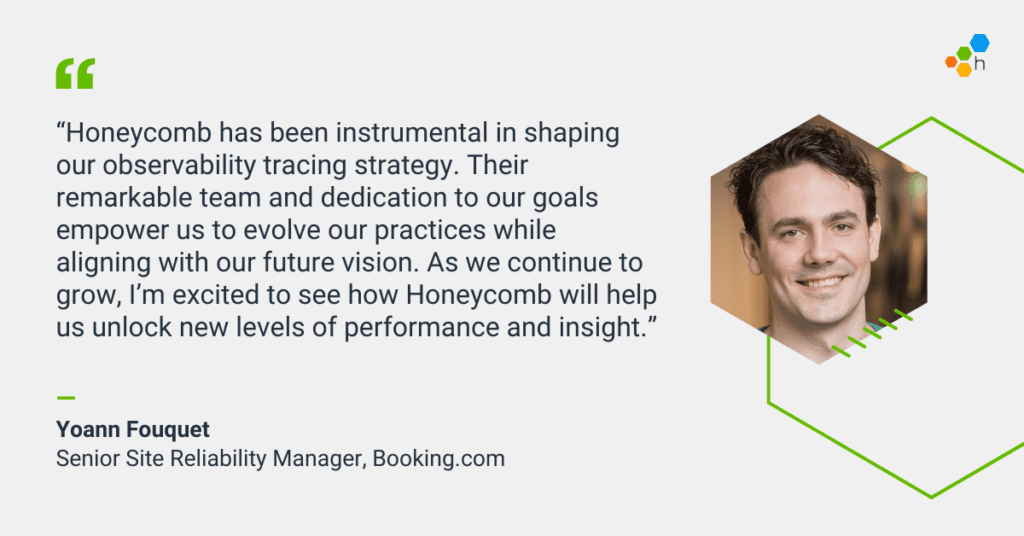Interested? Book a call with our experts.
Since its early startup beginnings in Amsterdam, Booking.com has redefined the travel industry, establishing itself as a premier platform for millions of travelers worldwide. With over 28 million accommodation listings and a staggering 1.5 million room nights booked every day, Booking.com operates on a scale that demands a robust and constantly monitored infrastructure. To cater to their diverse global clientele, the company has built an extensive hybrid cloud ecosystem that operates on-premise datacenters, private and public cloud providers across multiple regions.
In fact, Booking.com chose Honeycomb many years ago because it aligned with a vision they had for observability that was ahead of industry standards. The company was already generating and storing events for everything happening on their platform, and Honeycomb was the most suitable solution that made these events instantly searchable by any dimension.
The power of event-driven observability for A/B testing, compliance, and security
One of the critical challenges Booking.com faced as they scaled was the need for a robust method to validate their engineering decisions. As Yoann Fouquet, Senior Site Reliability Manager at Booking.com explained, “We needed to ensure we were on the right track, so we invested in A/B testing early on and built events specifically for that purpose.” Whenever engineers proposed changes to the platform, they would form a hypothesis and rely on events-based metrics to validate their assumptions.
This approach allowed the engineers to quickly determine whether their changes had the intended effect or if further adjustments were necessary. By building their metrics on events, they ensured that every action taken on the platform was fully trackable, measurable, and actionable. However, as Booking.com transitioned from a monolithic architecture to cloud-native microservices, the process became significantly more complex.
This was when Booking.com turned to Honeycomb. Honeycomb’s ability to integrate distributed tracing with events allowed engineering teams to seamlessly correlate data across their entire system. As Yoann explained, “With Honeycomb, we started using tracing to bring events together. We can aggregate logs with their corresponding events—tracking details like datacenter, availability zone, region, version, timestamp, node, persona, and more—all in one place. It gives us everything we need, quickly and efficiently, which is essential for our development needs.”
Honeycomb’s platform brought together event-driven data with distributed traces, helping Booking.com address their operational needs. This holistic view of requests, along with the associated metadata, has empowered the engineering teams to troubleshoot issues faster, maintain compliance, and identify security issues—such as determining whether incoming traffic is from a human or a bot.
Overcoming fragmentation across product verticals
As a global travel giant, Booking.com operates on a massive scale. With product verticals covering everything from accommodations, flights, car rentals, insurance, attractions, experiences, and more, each engineering group—dedicated to a specific product vertical—developed its own approach to monitoring and observability. Over time, this led to a fragmented approach, with teams relying on different tools.
“Each engineering vertical had its own observability stack. Flights might use one tool, while accommodations used another. There was no unified view, and this fragmentation created significant challenges when we encountered issues across product verticals,” explained Murugesan Ramaiah, Solutions Architect at Booking.com.
For example, a booking process could touch multiple services—starting with accommodation reservation systems, payments, car rental, etc. When problems arose, engineers couldn’t easily trace issues throughout the entire booking journey. The teams were spending too much time trying to correlate data across disconnected tools.
At the same time, the complexity of Booking.com’s systems had reached a point where no single person could have complete visibility over the entire path of a request. With frontend, backend, and product verticals intertwined, teams needed a unified approach to streamline incident response. “Unifying on Honeycomb as our central tracing system enabled anyone responding to incidents to easily trace issues across services,” said Murugesan. For instance, they could identify when to bring someone from the flight department in to help with a relevant issue, rather than being stuck in silos.
“Honeycomb handles our scale and complexity while offering insights into many of our services. The end-to-end tracing capabilities—and dynamic sampling using Honeycomb’s Refinery—allows our teams to focus on the most critical traces without being overwhelmed by noise,” said Murugesan. “This is critical when you’re dealing with millions of daily traces. With our massive volumes, we can’t store everything, so Refinery experimentation helps us focus on the most interesting and meaningful traces.”
Ease of use with rapid debugging in minutes
Honeycomb’s ability to provide unified tracing across all services has allowed Booking.com to correlate data rapidly, uncover root causes, and enhance system performance. This level of visibility has been transformative for engineers, accelerating troubleshooting and enabling a more proactive approach to problem-solving.
“In the past, when troubleshooting, it could sometimes take hours to figure out what was wrong. With Honeycomb, we’re debugging issues in minutes,” said Yoann. This agility has translated into an improved user experience—not just for engineers, but for the end users who depend on a seamless booking process. With Honeycomb’s intuitive interface, developers are empowered to quickly identify and resolve issues, minimizing performance hiccups and resulting in a consistently high-quality experience across flights, accommodations, car rentals, and more.
Yoann added, “Ultimately, it’s about creating a seamless user experience for our customers. If someone’s booking a flight and they want to add a car rental or a local tour, the entire process just works. The rich capabilities offered by Honeycomb, such as BubbleUp anomaly detection, have been instrumental for our dev team to ensure this level of integration and responsiveness.”
Beyond operational improvements, Honeycomb’s user-friendly design has facilitated widespread adoption across engineering and operations teams. “Honeycomb’s UI is refreshingly easy to use. We’ve seen more developers leveraging events to validate tests and debug faster. Adoption has extended beyond the engineering community—thanks to Honeycomb’s intuitive design, more people across the organization are jumping in and reaping the benefits,” said Murugesan.

Embracing OpenTelemetry for vendor-agnostic data integration
Since adopting Honeycomb, Booking.com has embraced a vendor-agnostic approach to data integration, standardizing on OpenTelemetry. This strategy reflects a commitment to flexibility and innovation, allowing engineering groups to connect seamlessly while leveraging Honeycomb’s powerful tracing capabilities.
“Some of our engineering teams have already adopted OpenTelemetry, giving them a head start in generating and enhancing data. What’s fantastic about Honeycomb is its native support for OpenTelemetry protocols—it understands the protocol without requiring any additional effort on our part. Honeycomb has also adapted to our in-house event systems. This capability allows us to harmonize our distinct event systems—our homegrown solution and OpenTelemetry—into a single, centralized observability vision within Honeycomb.”
With OpenTelemetry being adopted across nearly all platforms where their applications run, engineers can choose how they send events—whether through their existing event pipeline or via OpenTelemetry. “This flexibility has been transformative, enabling us to solve significant challenges while maintaining our operational integrity,” said Murugesan.
Moreover, Honeycomb’s dedication to OpenTelemetry aligns perfectly with Booking.com’s vision for enhanced observability. “As one of the largest contributors in the OpenTelemetry space, Honeycomb shares our belief in open standards and transparency. We are excited to collaborate with them to further enhance observability and data integration within our systems. Both companies are aligned on the same strategic path, which is incredibly motivating for our ongoing partnership,” added Yoann.
Looking ahead
As Booking.com continues to scale and evolve, the company’s commitment to observability remains steadfast. Honeycomb has proven to be an essential partner, helping the company bridge the gaps between product verticals, improve collaboration, and enable engineers to operate with greater autonomy and speed.

“Honeycomb has been instrumental in shaping our observability tracing strategy. Their remarkable team and dedication to our goals empower us to evolve our practices while aligning with our future vision. As we continue to grow, I’m excited to see how Honeycomb will help us unlock new levels of performance and insight,” said Yoann.

At a glance
About
Founded in 1996 in Amsterdam, Booking.com has evolved from a small Dutch startup into a global leader in the digital travel industry. Today, it stands as one of the world’s foremost travel platforms, offering services in 43 languages and featuring over 28 million accommodation listings. This extensive collection includes more than 6.6 million homes, apartments, and other unique places to stay, catering to the diverse needs of travelers everywhere. With a mission to empower everyone to experience the world, Booking.com is committed to enhancing the travel experience and making it easier for individuals to discover their perfect getaway. As the company continues to innovate and expand, Booking.com remains focused on delivering seamless and affordable travel solutions.
Industry
Travel and accommodation services
Products
Honeycomb platform
Use cases
Application performance monitoring
Incident debugging and reduction
Results
- Improved engineering collaboration across product verticals with centralized tracing
- Accelerated debugging from up to hours down to minutes
- Boosted developer productivity by simplifying troubleshooting processes
- Natively supported data collection using OpenTelemetry for greater flexibility









